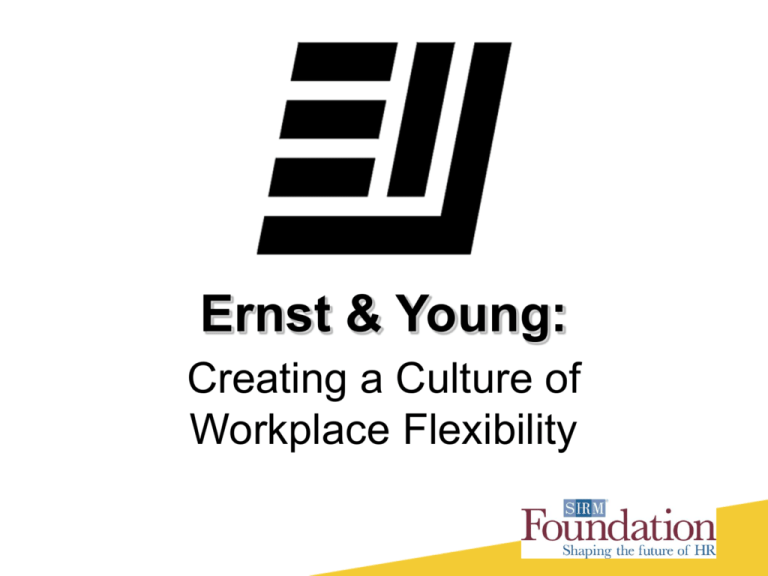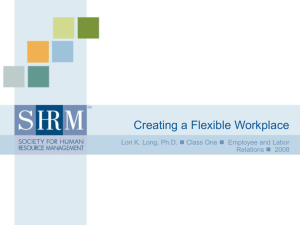Additional Questions
advertisement

Ernst & Young: Creating a Culture of Workplace Flexibility Video Overview • Hosted by Wayne Cascio, Ph.D. • SHRM Foundation’s 10th DVD • Filmed on Location at Ernst & Young’s Headquarters • Comprehensive Interviews • Officers, Managers, and Employees Video Synopsis • Video Introduction • Why is flexibility important? • The flexibility imperative • The role of technology • Making flexibility work • Attracting and retaining top talent • Implementing flexibility • • • Strong relationships • • • Advice to other leaders Flexibility at all levels Flexibility and cultural differences The future of flexibility Five Lessons in Flexibility Company Overview OPERATING INFORMATION •One of the “big four” accounting firms •Headquartered in London, England •167,000 employees worldwide (in 2012) •Operates in 140 Countries •Eighth-largest private company in the world •$24 Billion in Annual Revenue (in 2012) Company Overview GLOBAL BUSINESS • Divided into operating areas: - EMEIA (Europe, Middle East, India and Africa) - Americas - Asia-Pacific - Japan • Each area is managed independently with an Area Managing Partner who is a member of the Global Executive Board. Company Overview BUSINESSES: • Assurance Services (46% revenue share) • Tax Services (26% revenue share) • Advisory (19% revenue share) • Transaction Advisory Services (9% revenue share) Company Overview STAFFING PRACTICES •#1 in Forbes Magazine’s “The Best Accounting Firms to Work For,” 2012 •#1 in BusinessWeek’s annual list of Best Places To Launch a Career, 2008 •#44 in the Fortune list of 100 Best Companies to Work For, 2009 •#34 in ComputerWorld’s 100 Best Places To Work For In IT, 2009 •Top 50 in the “Where Women Want to Work” awards, 2007 •One of the 10 Best Companies for Working Mothers, Working Mother magazine, 2006 Discussion Questions What are the primary reasons for a business to incorporate flexibility? • Recruit and retain talent • Where is flexibility taking off? • Bilateral benefits Additional Questions • How does flexibility help retain employees? • How does flexibility help recruit high-quality employees? • How might a flexible work schedule benefit you? What types of flexibility arrangements are commonly implemented in today's businesses? • Compressed Work Weeks • Flexible Start and Stop Times • Scheduled Collaboration and Workforce Availability • Peak-Performance Scheduling Additional Questions • What are some reasons that a company might require a formalized flexible work schedule? • How can a company offer flexible work schedules to people whose presence in the workplace is absolutely required? • What are some of the trade-offs that employees and companies might have to accept as part of a flexible work agreement? Why is it important to offer flexibility to all employees, not just to those people with particular circumstances? • Remaining neutral • Protect morale • Make it accessible Additional Questions • Should a company be concerned with the activities that an employee participates in during his or her flextime? Why? • What industries are more likely to be able to accommodate flexible work arrangements? • What industries are less likely to be able to accommodate flexible work arrangements? How does technology enable effective flexibility? • Untether the Worker • High Availability • Shared Calendars Additional Questions • What cost savings exist at the intersection of flexibility and technology? • What considerations might an organization make for remote employees who primarily work outside the office? • How can technology, shift work, and flexible scheduling help limit the overhead costs associated with an expanding workforce? How can flexibility benefit a company’s customers/clients? • Flexibility is Universal • A Global Competitive Advantage • Be there for your customers Additional Questions • What are some benefits of flexible scheduling to the local community? • How can flexibility help a company expand productivity in a cost-effective way? • How does flexibility protect a productive workforce in a bad economy? How does flexibility enable a more productive global workforce? • Save on cost, burnout • Increase efficiency across borders • Decisions, decisions Additional Questions • How can compressed workweeks help increase global cooperation and productivity? • How do flexible work schedules help strengthen team relationships? • How might flexible work schedules negatively affect employees’ personal lives? Why do employees often value a flexible work arrangement over an increase in salary? • The Flexible Generation-Y • Outside the U.S. • Not Just Moms Additional Questions • Why has flexibility become such an important trend? • With flexibility becoming more popular, do companies even need offices? • Do telecommuting and flexible work schedules decrease productivity? What are some obstacles that could arise when implementing flexibility? • Adoption difficulties • Keeping in touch • Remaining consistent Additional Questions • Why are Baby Boomers adopting flexibility more slowly than any other generation? • What can an organization do to overcome the fears of flexibility? • What are the pros and cons of not having a companywide flexibility-implementation plan? What frameworks have been created to measure the success of flexibility? • The BOLD initiative • The ROWE initiative • An Accountability Model Additional Questions • What cost savings might an organization experience by implementing flexibility? • What expenses might a company incur as a result of implementing flexibility? How does flexibility help increase diversity? • Women in the workforce • People with disabilities • Employees with cultural obligations • People around the world • Senior citizens working longer Additional Questions • Why is diversity in the workplace important? • How does the move from the industrial age to the information age enable diversity in the workplace? • If you were given an opportunity to work on a flexible schedule, how do you think you would perform? Five Important Lessons 1. Flexibility is a two-way street. Yes, employees have to make their needs and concerns known to their managers, but managers need to let employees know that it is OK. They need to support them as they strive to find sensible solutions that work for the individual, his/her team, and the clients he/she serves. 2. As a leader, it’s up to you to initiate a conversation to discuss how accessible and connected you want your team or direct reports to be. Staff members are unlikely to begin that conversation because they don’t want you to misinterpret their question to mean, “I don’t want to work hard,” or “my career is not important to me.” Five Important Lessons 3. Call a meeting or have a 30-minute conference call to develop a “contract” with your fellow team members or direct reports that addresses clients’ expectations and deadlines as well as team-members’ needs. 4. Encourage teams to use team calendars to track key personal appointments, commitments, client deadlines, and other flexibility needs. 5. As a leader, always remember that people will watch your behavior closely – perhaps more closely than you may expect. If your public perspective on flexibility is inconsistent with your actions, people will imitate what they see.











